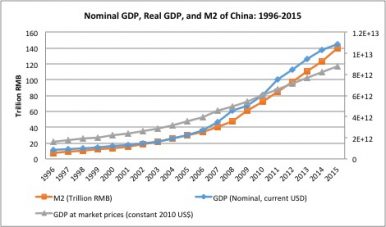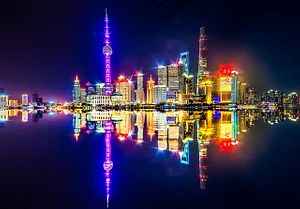The expression “New Normal” refers to a situation that is new, and perhaps even revolutionary. Today, Chinese President Xi Jinping is emerging in a series of international events – first at APEC in Beijing, then at the G20 in Hangzhou, and more recently at the World Economic Forum in Davos – as a global leader calling for a deepening of globalization. This emergence could represent a new game, and a departure from the classical dogma of economics textbooks.
In this game, at least within the Chinese economy, reform is about enhancing the monopoly power of state-owned corporations, so as to strengthen their competitive strength; stimulating domestic consumption is about tolerating bubbles in property prices and enlarging income inequality; pushing for internationalization of the currency is not mutually exclusive to keeping the capital account and foreign exchange under strict control; promoting exports, especially high value-added exports, is actually facilitated by an appreciating currency. Indeed, through these very efforts, the Chinese economy has managed to make a leap along the global value chain and revolutionize its industrial technologies, in almost every major sector of its economy, since 2008. Behind them all, of course, is the seemingly simple expedient of “printing money,” in principle. How could this be possible?

To answer that question, let’s look first at the so-called virtuous circle built into the Chinese economy in the post-2008 era, a period of accelerated growth in M2 decoupled from real GDP growth (as shown in the accompanying figure):
- The expansion of M2, which is driven by several monetary policy tools plus the printing of M1, together with tight controls on the supply of land as well as entry into the property development business, triggers and supports skyrocketing property prices;
- Local governments are able to live on income from taxes and sales related to land. Commonly now 30-40 percent (and in some places up to 60 percent) of local government income relies on the property market.
- The central government can then take a much larger share of tax income. Together with the income from newly printed money, in the form of government bonds or foreign exchange reserves, the central government seems to have more than enough financial resources to invest in defense, R&D, education, social insurance, and infrastructure.
- A greater monetary supply flowing into the economy means more jobs and higher income for households, together with a hyper-expansion in infrastructure stimulated by government expenditure and a rising value of household property assets. Society now not only spends more, but also spends on high-end products.
- We then see a rapid upgrading in the quality of products and services provided by domestic industries, and, of course, incessant waves of rich Chinese tourists flooding high-income countries and sweeping the shelves of every shopping center.
- Chinese companies, especially large and/or monopolistic firms, become super-rich because of the revenue amassed from a domestic market of 1.4 billion consumers who themselves feel wealthier in general. These companies use the cash, backed by commercial loans with government support, to acquire foreign technologies. If the transfer and licensing of technologies are not enough to satiate their appetite, they can, of course, also wield their cash and directly acquire the foreign companies that own the technologies, sometimes even paying premium prices two to three times the market evaluation. Those premiums are naturally expected to be recouped quickly, from the 1.4 billion-size market. So Chinese industries have really played a game of technological leap-frog since 2008. The truly ambitious ones will subsequently conduct incremental innovations based on the absorbed foreign technologies, and thus develop the technological competitiveness needed to take a share of the global market.
- The Chinese economy has another advantage in all of the above: a stable and appreciating currency. This owes to a tightly managed capital account, its $3-4 trillion in foreign reserve, as well as many years of current account surpluses from trade. A strong currency endows the newly printed money with high purchasing power, not only to exchange for resources – oil and minerals – from overseas, but also to acquire all sorts of assets as its overseas investment. Welcome to the “One Belt, One Road”!
- A strong currency policy also supports the internationalization of the currency. For a while, people started talking about the oil RMB, partially replacing the oil U.S. dollar. This windfall income – the printed RMB that will remain in circulation in the global economy and hardly ever return to China – also helps boost consumption and investment, domestically as well as overseas.
This story about the rise of China is also a clear departure from the classical models under which other Asian industrialized economies, such as Japan, South Korea, Singapore and Hong Kong, had arisen. The classical models used to rely on import substitution, export-led, the flying geese paradigm, and the move from OEM to ODM (short for, respectively, “Original Equipment Manufacturer” and “Original Design Manufacturer”). Should we rewrite our economics textbooks to show other lesser developed countries how to follow a successful path? At the very least we should recognize that China has pursued the above strategies to create its own force of internal demand, at a time when struggling U.S. and European economies were unable to act as world economic engines. Of course, Western economies still hold out hope that the world will want their T-bills, bonds, and CDS. But will it?
In the coming decade or two, two outcomes of this virtuous circle of the “New Normal” need to be watched closely. The first is rising property prices. The second is the technological leapfrogging, or industrial upgrading, that China has achieved to date. The former represents the threat of a bursting of the economic bubble. The latter represents surging economic productivity and a long-term foundation for further prosperity. However, the property bubble has hijacked monetary supply and is not easy to tame. We have yet to see what extraordinary policies and leadership the elites of the Chinese economy will come up with to resolve the situation. Should we expect to see a Chinese economy that continues to boom on the strength of a property bubble for another decade? That seems unlikely. Someone must find an exit strategy in the form of a “soft landing” now. Otherwise, scrapping our economics textbooks might be premature.
Dr Yanfei Li is an Energy Economist of the Economic Research Institute for ASEAN and East Asia (ERIA). He specializes in energy markets, energy policy, and economics of technological change, serving the interests of both academic and public sectors.

































